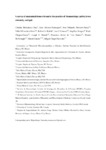A survey of anatomical items relevant to the practice of rheumatology: pelvis, lower extremity, and gait

Use este enlace para citar
http://hdl.handle.net/2183/30665Coleccións
- Investigación (FCS) [1293]
Metadatos
Mostrar o rexistro completo do ítemTítulo
A survey of anatomical items relevant to the practice of rheumatology: pelvis, lower extremity, and gaitAutor(es)
Data
2017-06-01Cita bibliográfica
Hernández-Díaz C, Alvarez-Nemegyei J, Navarro-Zarza JE, Villaseñor-Ovies P, Kalish RA, Canoso JJ, Vargas A, Chiapas-Gasca K, Biundo JJ, de Toro Santos FJ, McGonagle D, Carette S, Saavedra MÁ. A survey of anatomical items relevant to the practice of rheumatology: pelvis, lower extremity, and gait. Clin Rheumatol. 2017 Dec;36(12):2813-2819.
Resumo
[Abstract] This study aimed to generate a minimum list of structural and functional anatomical items about the pelvis/hip, knee, ankle/foot, gait, and lower limb innervation, which are most relevant to the practice of rheumatology. To determine their perceived relevance to clinical practice, seven members of the Mexican Clinical Anatomy Task Force compiled an initial list of 470 anatomical items. Ten local and international experts according to a 0-10 Likert scale ranked these items. Of the original list, 101 (21.48%) items were considered relevant (global rate >40). These included 36/137 (26.27%) pelvis and hip items, 25/82 (30.48%) knee items, 22/168 (13.98%) ankle/foot items, 11/68 (16.17%) neurologic items, and 7/15 (46.66%) gait-related items. We propose that these 101 anatomical items of the lower extremity, when added to the 115 anatomic items of the upper extremity and spine we previously reported, may represent an approximation to the minimal anatomical knowledge central to the competent practice of rheumatology. The meager representation of ankle and foot items may reflect a lesser emphasis in these anatomical regions during rheumatologic training. Attention to these and related items during rheumatologic training and beyond may sharpen the rheumatologist's ability in the differential diagnosis of regional pain syndromes as well as strengthen an endangered art: the rheumatologic physical examination.
Palabras chave
Clinical anatomy
Physical examination
Regional pain syndromes
Rheumatology education
Physical examination
Regional pain syndromes
Rheumatology education
Versión do editor
Dereitos
This version of the article has been accepted for publication, after peer review and is subject to Springer Nature’s AM terms of use, but is not the Version of Record and does not reflect post-acceptance improvements, or any corrections. The Version of Record is available online at Springer Link web page.
ISSN
0770-3198





